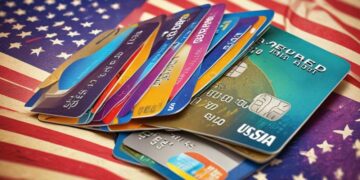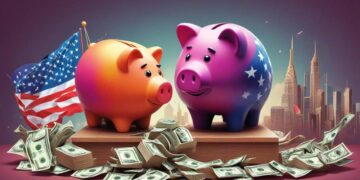Difference between personal loan and payday loan in the United States

Key Differences Between Personal Loans and Payday Loans
In the realm of borrowing, understanding the distinctions between a personal loan and a payday loan is crucial for effective financial planning. Each loan type possesses unique characteristics that cater to varying financial situations, making it essential for borrowers to comprehend these differences for informed decision-making.
Characteristics of Personal Loans
Personal loans are generally recognized for their more favorable terms, making them suitable for a range of financial needs, from large purchases to debt consolidation. Here are some key features:
- Loan amount: Personal loans typically range from $1,000 to $50,000. This broad range allows borrowers to choose an amount that best fits their needs, whether it’s for a major expense such as a home renovation or for covering unexpected medical bills.
- Repayment terms: The repayment duration for personal loans usually spans one to five years. This extended repayment period can make monthly payments more manageable, preventing borrowers from facing financial strain.
- Interest rates: The interest rates on personal loans are often lower than those of payday loans, averaging between 6% to 36% APR. This lower rate can significantly reduce the total cost of borrowing, making personal loans a more financially sound option.
Understanding Payday Loans
In contrast, payday loans are designed for urgent financial needs but come with substantial risks and drawbacks. Their defining characteristics include:
- Loan amount: Payday loans are generally limited to $500 or less. This small loan cap often addresses immediate cash shortages but may not suffice for larger, more significant financial needs.
- Repayment terms: These loans typically must be repaid within two to four weeks, often synchronized with the borrower’s payday. This short repayment window can lead to a challenging cycle of debt if the borrower is unable to repay in full on time.
- Interest rates: The interest rates can be exceedingly high, with APRs that can exceed 400%. Such exorbitant rates can result in borrowers paying back much more than the original loan amount, leading to severe financial repercussions.
Impact on Financial Health
Knowing these differences is essential when deciding which loan option is most suitable for your circumstances. In the United States, the choice between a personal loan and a payday loan can profoundly impact one’s financial health. Personal loans often foster better debt management and enhance overall financial stability, providing a structured approach to borrowing that aligns with long-term financial goals. In contrast, reliance on payday loans can lead to a continuous cycle of borrowing that negatively affects credit scores and financial well-being.
Ultimately, the informed choice between a personal loan and a payday loan depends on individual circumstances, including the amount needed, the timeline for repayment, and the capacity to handle interest rates effectively. Understanding these various factors allows individuals to make decisions that align with their overall financial health and future goals.
Understanding the Implications of Loan Type Selection
When examining the differences between personal loans and payday loans, it is imperative to delve deeper into the implications of each loan type for borrowers’ financial health. The characteristics of these loans not only influence the immediate cash flow but also have long-lasting effects on credit standing and financial stability.
Evaluating Personal Loans: Benefits and Considerations
The appeal of personal loans lies in their flexibility and structured repayment options. Borrowers considering a personal loan should take into account the following benefits:
- Credit Score Impact: Personal loans can positively influence a borrower’s credit score when managed responsibly. Timely payments contribute to a better credit history, which may facilitate access to lower interest rates on future loans.
- Purpose of Use: Personal loans can serve multiple purposes, ranging from consolidating existing debt to funding personal projects or unexpected expenses. This versatility allows borrowers to tailor the loan to their specific needs.
- Fixed Payments: Many personal loans have fixed interest rates, leading to predictable monthly payments. This predictability is beneficial for budgeting and financial planning, as borrowers know exactly what to expect each month.
Despite these benefits, it is essential for borrowers to exercise due diligence when selecting a personal loan. Factors such as the lender’s reputation, loan terms, and associated fees should be thoroughly reviewed to prevent unexpected costs.
Payday Loans: The Risks and Drawbacks
Conversely, payday loans may provide immediate liquidity but carry significant risks that can jeopardize a borrower’s financial stability. Key aspects to consider include:
- High Fees and Interest: Payday loans typically come with exorbitant fees and interest rates that can lead to a substantial total repayment amount that far exceeds the original loan. This situation often traps borrowers in a cycle of debt.
- Debt Cycle Consequences: Borrowers might find themselves needing to take out additional payday loans to repay existing ones, leading to an unsustainable cycle. This situation can severely affect financial security and overall creditworthiness.
- Limited Lending Limits: With a cap on loan amounts, borrowers must often consider if payday loans can adequately meet their financial needs, which may leave them short during more significant financial emergencies.
In summary, understanding the implications of choosing between personal loans and payday loans is vital for anyone considering borrowing in the United States. While personal loans provide more manageable repayment options and can facilitate financial growth, payday loans pose considerable risks that can lead to negative financial consequences. By assessing personal circumstances and understanding the terms of each loan type, borrowers can navigate the lending landscape more effectively.
Comparing Loan Access and Borrower Eligibility
Another critical aspect of understanding personal loans versus payday loans is the variation in access and borrower eligibility. These differences can significantly impact a borrower’s choice and their overall financial health.
Access to Personal Loans: Criteria and Limitations
Personal loans typically require a more thorough application process compared to payday loans. Lenders assess borrowers based on their creditworthiness, which encompasses several factors:
- Credit Score Requirements: Most lenders establish minimum credit score thresholds, often ranging from 580 to 700. A higher credit score can result in better interest rates and terms.
- Income Verification: Applicants are usually required to provide documentation of their income, which ensures that they can make repayment. This process may include submitting pay stubs, tax returns, or bank statements.
- Debt-to-Income Ratio: Lenders often evaluate the borrower’s debt-to-income (DTI) ratio, which indicates the proportion of income that goes towards debt repayment. A lower DTI ratio signifies a more favorable borrowing capacity.
While these criteria help ensure responsible lending, they can also act as barriers for individuals with poor credit histories or unstable income. As a result, potential borrowers may find it challenging to secure personal loans unless they meet these conditions.
Payday Loans: Easier Access with High Costs
In contrast, payday loans are often more accessible to those in immediate financial need. However, this accessibility comes at a price:
- No Credit Check: Payday lenders typically do not conduct rigorous credit checks, allowing borrowers with bad credit histories to obtain loans quickly. However, this lack of scrutiny can lead to unsustainable borrowing.
- Rapid Approval Process: Most payday loans can be approved within minutes, providing immediate funding. This rapid process appeals to individuals facing urgent monetary needs, but it often results in impulsive borrowing decisions.
- Local Availability: Payday lenders are often found in convenience stores and check-cashing locations, making them easy to access. However, this convenience can deter borrowers from exploring more prudent financial options.
The trade-off for the swift access to payday loans is a higher likelihood of falling into a debt cycle, characterized by taking out multiple loans to cover existing obligations. As highlighted earlier, this can have a detrimental impact on an individual’s fiscal health.
Loan Terms and Repayment Structures
A pivotal distinction between personal and payday loans also lies in their repayment terms and structures. Understanding these differences is crucial for making informed borrowing decisions:
- Repayment Period: Personal loans generally offer extended repayment periods ranging from one to five years, allowing borrowers to make manageable monthly payments. Conversely, payday loans are designed to be repaid within a few weeks, often by the borrower’s next paycheck.
- Prepayment Penalties: Many personal loans allow for early repayment without penalties, giving borrowers the flexibility to pay off the loan sooner without incurring additional costs. In contrast, payday loans typically do not have these provisions.
- Loan Amount Diversity: Personal loans can vary significantly in amounts, with some lenders offering loans of up to $100,000. Payday loans, on the other hand, are usually capped at around $500 to $1,000, insufficient for larger expenses.
In summary, the nuances of access, eligibility criteria, and repayment structures of personal and payday loans form an integral part of the decision-making process for potential borrowers. While personal loans offer terms that can be conducive to long-term financial health, payday loans present greater risks, often leading to financial instability. Understanding these differences empowers borrowers to make informed choices aligned with their financial situations.
Conclusion
In conclusion, understanding the difference between personal loans and payday loans is essential for consumers in the United States to make informed financial decisions. Personal loans are characterized by their thorough application processes, reliance on creditworthiness, and structured repayment options that typically span several years. This makes them a far more favorable choice for individuals seeking to manage larger expenses or consolidate debt, as they often come with lower interest rates and flexible repayment terms.
On the other hand, payday loans provide immediate access to cash without extensive credit checks, catering to those in urgent need. However, the ease of obtaining these loans is overshadowed by their high costs and potential for cycle debt, which can adversely affect consumers’ long-term financial health. The rapid approval process, while appealing, can lead to hasty financial decisions, resulting in a pattern of borrowing that may perpetuate financial instability.
Ultimately, consumers must carefully assess their financial needs and circumstances before choosing between these loan options. While personal loans can offer a more sustainable solution, they may be out of reach for some individuals. Conversely, while payday loans are more accessible, they pose significant risks and should be approached with caution. By weighing the pros and cons and seeking alternatives when necessary, borrowers can work towards making sound financial choices that better serve their long-term well-being.
Related posts:
Maximizing Your Benefits: A Deep Dive into the Bank of America Premium Rewards Credit Card
A Comprehensive Guide to Maximizing Benefits with the Chase Freedom Unlimited Card
How Credit Cards Can Help Build a Solid Credit History
Exploring the World of Elite Perks with the HSBC Premier World Mastercard
How to Avoid Bank and Financial Fees on American Accounts
How to Apply for Firstcard Secured Credit Builder Card A Step-by-Step Guide

Beatriz Johnson is a seasoned financial analyst and writer with a passion for simplifying the complexities of economics and finance. With over a decade of experience in the industry, she specializes in topics like personal finance, investment strategies, and global economic trends. Through her work on Web Dinheiro, Beatriz empowers readers to make informed financial decisions and stay ahead in the ever-changing economic landscape.






